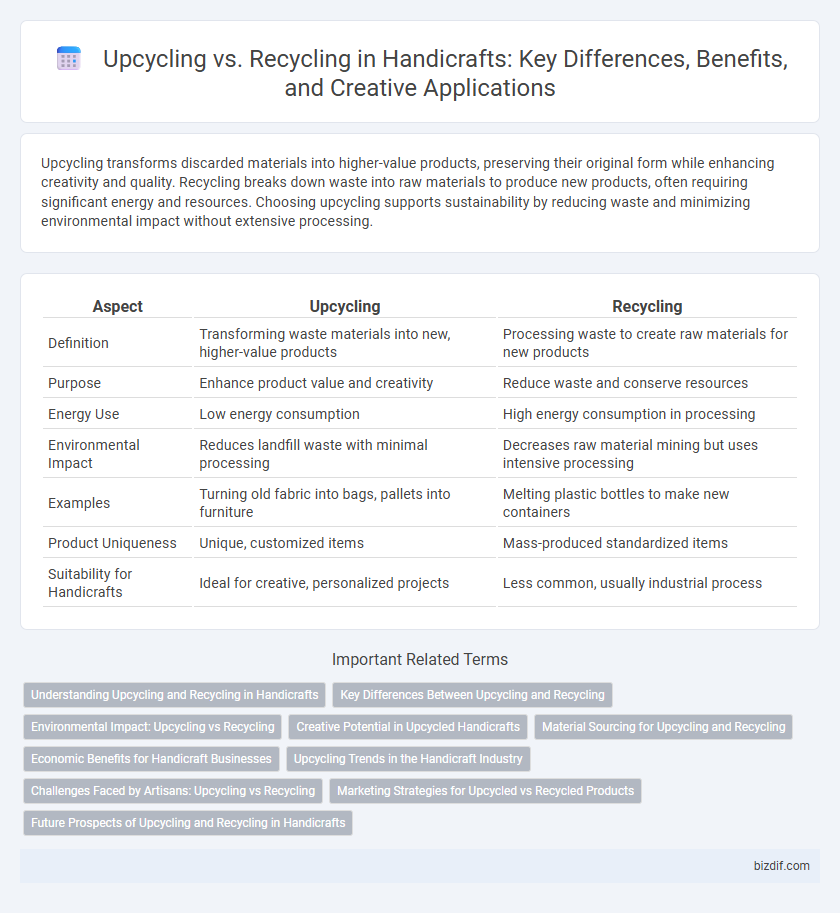Upcycling transforms discarded materials into higher-value products, preserving their original form while enhancing creativity and quality. Recycling breaks down waste into raw materials to produce new products, often requiring significant energy and resources. Choosing upcycling supports sustainability by reducing waste and minimizing environmental impact without extensive processing.
Table of Comparison
| Aspect | Upcycling | Recycling |
|---|---|---|
| Definition | Transforming waste materials into new, higher-value products | Processing waste to create raw materials for new products |
| Purpose | Enhance product value and creativity | Reduce waste and conserve resources |
| Energy Use | Low energy consumption | High energy consumption in processing |
| Environmental Impact | Reduces landfill waste with minimal processing | Decreases raw material mining but uses intensive processing |
| Examples | Turning old fabric into bags, pallets into furniture | Melting plastic bottles to make new containers |
| Product Uniqueness | Unique, customized items | Mass-produced standardized items |
| Suitability for Handicrafts | Ideal for creative, personalized projects | Less common, usually industrial process |
Understanding Upcycling and Recycling in Handicrafts
Upcycling in handicrafts involves creatively transforming discarded materials into higher-value, unique products, enhancing sustainability by reducing waste. Recycling breaks down waste materials to produce raw inputs for new items, often resulting in lower-value goods compared to the original. Understanding the distinction helps artisans choose techniques that preserve material integrity and maximize environmental benefits within craft practices.
Key Differences Between Upcycling and Recycling
Upcycling involves creatively transforming discarded materials into products of higher value or quality, preserving original materials and reducing waste creatively. Recycling breaks down waste materials into raw components to produce new items, often consuming significant energy and altering the material's original form. Upcycling emphasizes design innovation and resourcefulness, while recycling focuses on material recovery and environmental processing.
Environmental Impact: Upcycling vs Recycling
Upcycling transforms waste materials into higher-quality products, significantly reducing landfill use and conserving resources by minimizing the need for raw material extraction. Recycling breaks down materials to create new products, but often requires substantial energy and can lead to downcycled items with lower value. Upcycling's environmental impact is often more favorable by promoting creativity and resource efficiency, while recycling remains essential for managing waste that cannot be upcycled.
Creative Potential in Upcycled Handicrafts
Upcycling in handicrafts transforms discarded materials into unique, high-value creations, showcasing exceptional creative potential beyond traditional recycling methods. By repurposing items with artistic innovation, upcycled crafts foster sustainability while preserving distinct aesthetic and functional qualities. This approach not only reduces waste but also encourages artisans to experiment with diverse textures, colors, and forms, enhancing the originality of each piece.
Material Sourcing for Upcycling and Recycling
Upcycling sources materials directly from discarded or unwanted items, transforming them into higher-value products without breaking down the original components. Recycling involves collecting, processing, and converting waste materials into raw inputs, often requiring energy-intensive procedures to reformulate substances like plastics, metals, or paper. Sustainable material sourcing in upcycling reduces environmental impact by minimizing industrial processing and extending the lifecycle of handcrafted goods.
Economic Benefits for Handicraft Businesses
Upcycling in handicraft businesses generates higher economic returns by transforming waste materials into unique, value-added products that command premium prices. Recycling often involves lower profit margins due to commodity pricing and extensive processing costs, whereas upcycled goods capitalize on creative design and market differentiation. Emphasizing upcycling boosts local economies through skilled labor demand and attracts eco-conscious consumers willing to pay more for sustainable handcrafted items.
Upcycling Trends in the Handicraft Industry
Upcycling in the handicraft industry transforms discarded materials into valuable, unique products, aligning with growing consumer demand for sustainable and eco-friendly goods. Artisans increasingly incorporate upcycled fabrics, wood, and metal into their creations, promoting creativity and reducing environmental impact. This trend not only fosters innovation but also supports local economies by encouraging small-scale, resourceful craftsmanship.
Challenges Faced by Artisans: Upcycling vs Recycling
Artisans face distinct challenges when choosing between upcycling and recycling, as upcycling demands creative skills to transform discarded materials into unique, value-added products, often requiring more time and craftsmanship. Recycling involves breaking down materials to their base form, which can limit design possibilities and requires access to specialized facilities or equipment. Limited market awareness and inconsistent supply of quality raw materials further complicate both upcycling and recycling for artisans striving to maintain sustainability and profitability.
Marketing Strategies for Upcycled vs Recycled Products
Marketing strategies for upcycled products emphasize unique craftsmanship and storytelling, appealing to eco-conscious consumers seeking originality and sustainability. In contrast, recycled products are promoted through standardized eco-certifications and scalability benefits, targeting mass-market demand for affordability and environmental responsibility. Highlighting the artisanal value and limited edition nature of upcycled goods creates emotional engagement, while recycled items leverage industry compliance and broad accessibility in their branding.
Future Prospects of Upcycling and Recycling in Handicrafts
Upcycling in handicrafts offers sustainable growth by transforming discarded materials into unique, high-value products, appealing to eco-conscious consumers and artisans alike. Recycling supports material reusability but often results in lower-grade raw materials, limiting creative potential in handicraft applications. Future trends indicate a surge in upcycling innovations, driven by increased environmental awareness and demand for personalized, ethically-made handicraft items.
Upcycling vs Recycling Infographic

 bizdif.com
bizdif.com